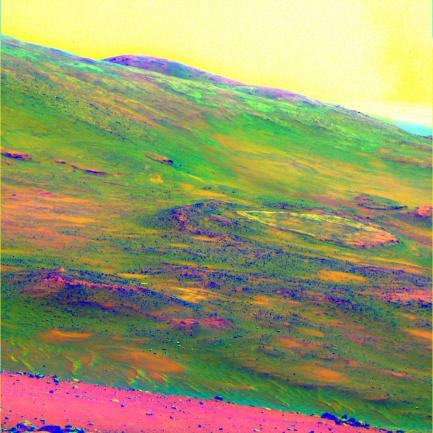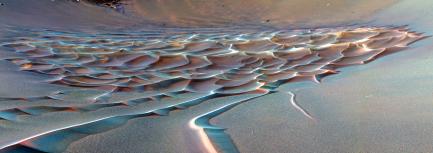Rover tracks disappear toward the horizon like the wake of a ship across the desolate sea of sand between the craters Endurance and Victoria on the Meridiani Plains. Opportunity took the image while stuck in the sand ripple dubbed Purgatory for over a month.
National Air and Space Museum Traces Decade of Rover Discoveries
“Spirit and Opportunity: 10 Years Roving Across Mars,” a collection of remarkable photographs of the red planet, opens Jan. 9 at the Smithsonian’s National Air and Space Museum. The exhibition chronicles NASA’s Mars Exploration Rover mission, which has helped shape a new view of how the planet has evolved. Designed to evaluate geologic history and evidence for past water, the mission was expected to last about 92 Earth days, or 90 “sols” (Martian days); however, Spirit performed for more than six years and Opportunity is still operating. The exhibition marks the 10th anniversary of the rover landings, which occurred on opposite sides of Mars, in January 2004.
“This set of spectacular images captures the beauty of Mars while telling the amazing stories of Spirit and Opportunity as they explored water-related deposits,” said John Grant, supervisory geologist in the museum’s Center for Earth and Planetary Studies and chair of the Science Operations Working Group on the mission. Because the mission has resulted in so many photographs, Grant, who curated the exhibition, polled fellow members of the mission team to identify images that were scientifically, historically and artistically meaningful.
Located in the museum’s “Flight and the Arts” gallery, the show brings art and science together in compelling images of craters, hills, dunes, dust clouds, meteorites and formations of rocks and spherules (miniature spheres called “blueberries”). A sublime view of the sun setting over the rim of Gusev Crater, where Spirit landed, seems eerily similar to scenes on earth. A Pancam image by Opportunity, enhanced with color to show geological differences, makes the ancient, highly eroded Erebus Crater appear to be glowing. And a stunning panoramic view, “Abstract Dunes,” evokes the words of Ralph Bagnold, a pioneer explorer of deserts, who said that dune formation “by its grotesque imitation of life, is vaguely disturbing to an imaginative mind.”
The centerpiece of the exhibit is a panoramic photo blow-up, wrapping two entire walls that surround a case holding a full-scale model of a rover. The effect is to give the visitor a sense of being on Mars. The exhibition includes several pieces of equipment, including a wheel used in testing rovers on Earth. It features three videos: an animation of a rover descending and landing, and two compilations of images shot on the planet, one by Spirit, the other by Opportunity.
The twin rovers were launched toward Mars in the summer of 2003. When they arrived the following January, they made a harrowing descent through the thin atmosphere, parachuting to the surface where they bounced down on inflated airbags. Both rovers made discoveries relating to the role of water in shaping the surface, findings that suggest past environments could have been habitable. The driving goal for each was 1 kilometer (about 2/3 mile). Spirit traversed more than 7.7 kilometers exploring volcanic plains, impact craters, the Columbia Hills and volcanic deposits. Opportunity, which landed on the Meridiani Plains, had traversed more than 38 kilometers by August 2013. It has explored sedimentary rocks, meteorites, and impact craters and their deposits.
In many of the photos of landscapes and geological formations taken by the rover cameras (Pancam, navigational cameras, hazard avoidance cameras, Microscopic Imager) there are views of rover equipment, shadows made by the rovers, and, in some particularly dramatic shots, the tracks the rovers left behind. One such image records tracks disappearing toward the horizon like the wake of a ship in a sea of sand. Opportunity took the image while stuck in a sand ripple dubbed “Purgatory” for more than a month.
“Spirit and Opportunity: 10 Years Roving Across Mars” was made possible through the support of Cornell University, the Jet Propulsion Laboratory, California Institute of Technology and the National Aeronautics and Space Administration.
The National Air and Space Museum building on the National Mall in Washington, D.C., is located at Sixth Street and Independence Avenue S.W. The museum’s Steven F. Udvar-Hazy Center is located in Chantilly, Va., near Washington Dulles International Airport. Attendance at both buildings combined exceeded 8 million in 2013, making it the most visited museum in America. The museum’s research, collections, exhibitions and programs focus on aeronautical history, space history and planetary studies. Both buildings are open from 10 a.m. until 5:30 p.m. every day (closed Dec. 25).
# # #
SI-517-2013
Alison Wood
202-633-2376






